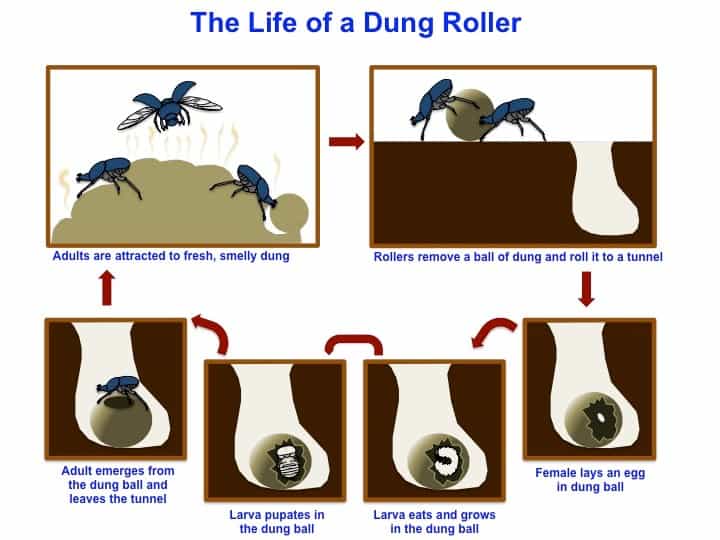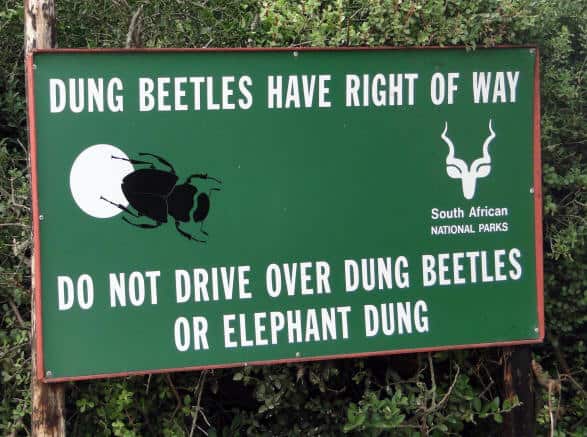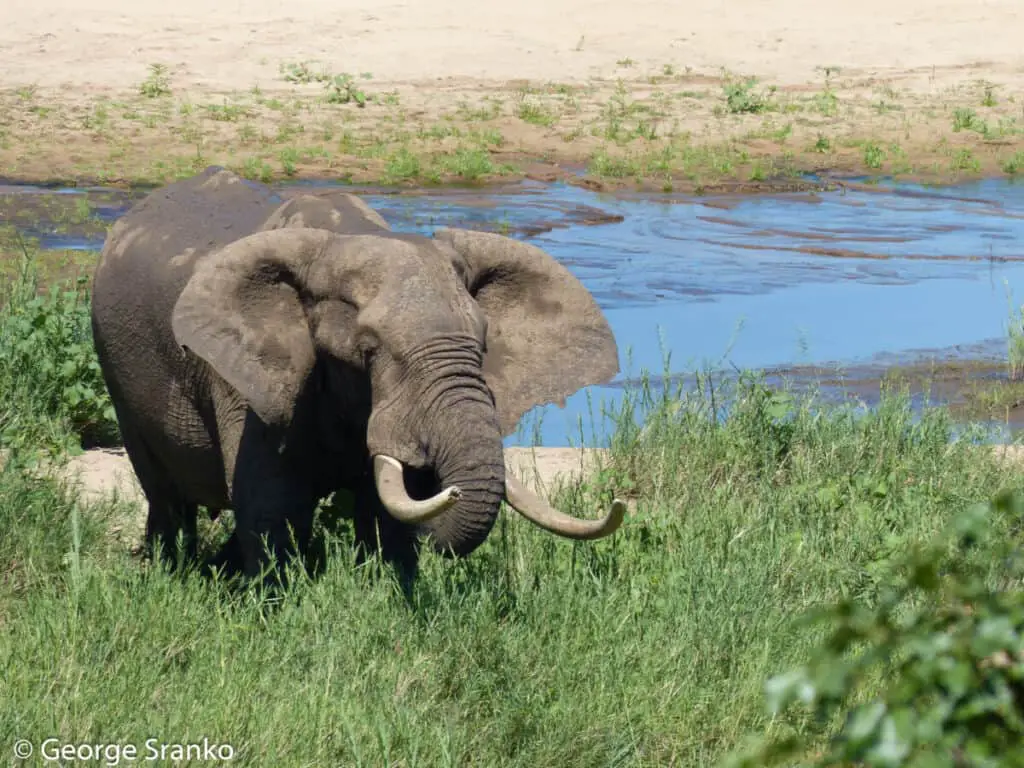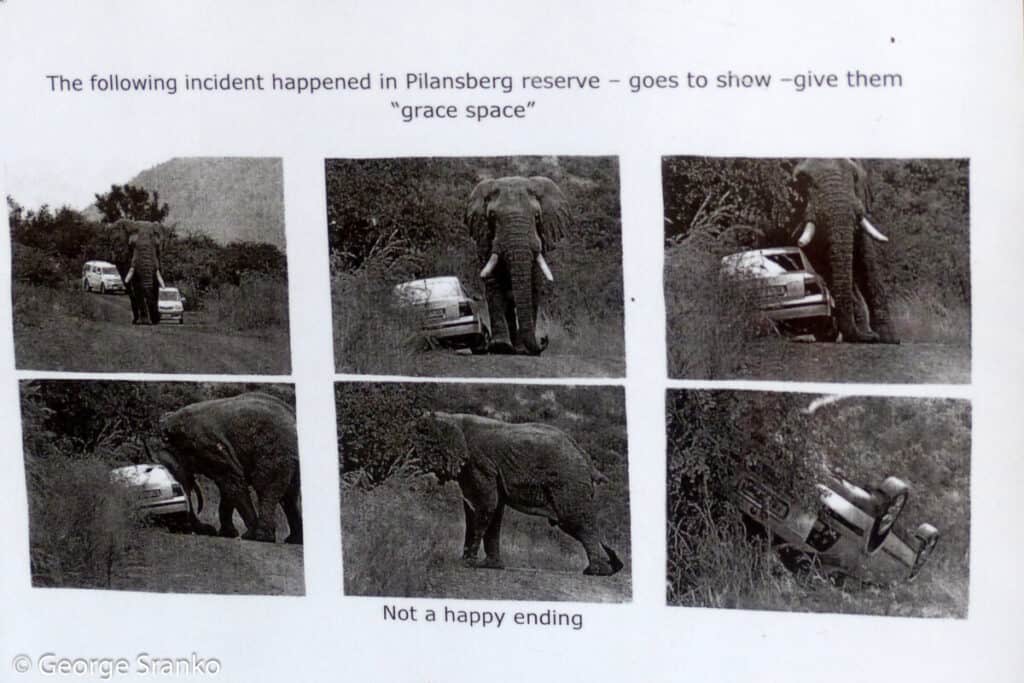One of our favorite activities in Africa is to watch elephants in the wild. Anywhere, anytime! They are such intelligent caring creatures. And the babies are fun to watch. One of the most surprising things about elephants is the role they play in creating the ecosystems they call home.
Elephants play an important role in the ecosystem by actively creating and maintaining savannas and grasslands. As ecosystem engineers elephants dig deep waterholes, tear down trees, provide shelter for other species, distribute seeds, fertilize and enrich the soil, and trample vast areas.
Why are Elephants Ecosystem Engineers?
Scientists are discovering that elephants not only live in their habitat, but they help shape the iconic African savannas and grasslands.
Elephants are often referred to as ecosystem engineers because of the powerful impact they have on most components of their ecosystem, including other animals, plants, insects and even the availability of water. Elephants can alter plant diversity and are a major cause of loss of trees in savanna systems, especially of tall trees.

Generations of elephants often use familiar trails for centuries, creating deep incisions that extend for many kilometers along migration routes. Elephants, digging in search of water or minerals, may remove several cubic meters of sediment in each excavation. Wallowing elephants may remove up to a cubic meter of pond sediments each time they visit a water source.
One of the best places to see elephants in the wild is at their favorite watering hole. Elephants are closely tied to a water source since they drink a bathtub full of water per day; about 50 gallons (200 liters).
In Kruger NP, we’ve watched elephants wallowing in mud holes, obviously enjoying the cooling effect of the water and the muddy protection against insects. As they rolled and frolicked in the muddy slurry, they would often dig at the banks with their tusks, enlarging the water hole and creating even more mud.

We could see that the elephants not only came down to the waterhole for a drink and a mud bath, but they were enlarging the ponds and digging even deeper holes. In many locations, elephants dig into clay banks specifically for essential micronutrients, such as manganese and cobalt, and regularly walk considerable distances to reach these sediments.
It is not difficult to imagine the impact elephants would have on the landscape by digging holes and walking the same paths day after day for thousands of years.
Not only are elephants ecosystem engineers – they are earthmovers!

The World Wildlife Fund estimates that there are roughly 400,000 elephants living in Africa today. In 1930, as many as 10 million wild elephants roamed the African continent.
Elephants create the savanna they call home
The African savanna is immediately recognizable when you see photos of the open grasslands dotted with the iconic flat-topped Acacias and upside-down Boabab trees. There are also Marula and Jackalberry trees that grow up to 60-80 feet tall, or over 20 m. Both have delicious fruit highly sought after by many animals, including elephants.
Savanna elephants graze extensively on grasses, but they also browse on a wide variety of shrubs, trees, and fruits. Their diet varies with the time of year; grass is preferred during the rainy season. In the dry season the dry grass provides poor nutrition, so elephants must browse more on woody vegetation, including leaves, twigs, and bark. Heavy feeding on woody plants can damage and kill entire stands of trees and bushes, opening the bushland to make way for grasslands.

Another role for the elephants is seed dispersal. They are not the most efficient when it comes to digesting food and only digest half of what they eat. It takes one or two days of passage time in the gut before all that plant material is digested. When the elephant defecates it can be miles from the original source of the food. It is through elephant dung that undigested seeds and nuts are distributed far and wide, increasing biodiversity and resilience of the ecosystem.
Elephants are surprisingly destructive in their eating habits. They routinely push over tall trees to feed on the tender leaves in the upper canopy and often strip bark from live trees for nourishment. In places with high elephant populations you’ll see dozens of trees flattened with the roots exposed, sticking vertically out of the ground. At first, when we saw the numbers of trees affected, we found it disconcerting! Of course, the dynamics of natural ecosystems are more complex than initially meet the eye.
Savanna elephants, not surprisingly, prefer savanna over forest. By pushing tall trees over elephants are taking an active role in creating their preferred landscape, even though they are just feeding themselves. We can see that the African landscape would look completely different without the active role that elephants perform.
The Gear We Love for Research Expeditions
We love to travel in search of exceptional wildlife viewing opportunities and for life-enhancing cultural experiences.
Here is the gear we love to travel with for recording our adventures in safety and comfort:
- Action Camera: GoPro Hero10 Black – we find these waterproof cameras are invaluable for capturing the essence of our adventures in video format. Still photos are great, but video sequences with all the sights and sounds add an extra dimension. I use short video clips to spice up many of my audiovisual presentations.
- Long Zoom Camera: Panasonic LUMIX FZ300 Long Zoom Digital Camera – I love this camera for its versatility. It goes from wide angle to 28X optical in a relatively compact design. On safari in Africa I’ve managed to get good shots of lions that the folks with long lenses kept missing – because the lions were too close! I also like the 120 fps slow-motion for action shots of birds flying and animals on the move. I call this my “bird camera.”
- 360 Camera: Insta360 ONE R 360 – 5.7K 360 Degree Camera, Stabilization, Waterproof – see my article How to Take Impossible Shots with Your 360 Camera. This camera is literally like taking your own camera crew with you when you travel! Read my article and you’ll see why.
- Backpack camera mount: Peak Design Capture Clip
- Drone: DJI Mini 2 (Fly More Combo) – this mini drone is made for travel!
- Water Filtration: LifeStraw Go Water Filter Bottle
- Binoculars: Vortex Binoculars or Vortex Optics Diamondback HD Binoculars (good price)
How Dung Beetles Play a Crucial Role
Elephants are among the greatest fertilizers of the African savannas. Each adult elephant consumes up to 600 pounds, or 270 kg, of vegetation every day, although 250 -300 lbs is more typical. Intake means output.
Each elephant defecates about 15-20 times per 24 hours, adding up to roughly 200 to 400 pounds, or 100-200 kg, of dung per day. Every year an adult elephant produces over 85,000 pounds of manure, more than 40 tons. Multiply that by hundreds of thousands of savanna elephants. That is a lot of elephant dung. And it is rich in nutrients since elephants only digest about half of what they eat.
Imagine having an elephant in your back yard. At the rate we’re talking about it wouldn’t be long before your backyard was completely covered in several feet of manure or dung.
Fortunately, it’s a different story in the savannas of Africa. A clean-up crew is busily on patrol 24/7! Dung beetles appear as soon as they smell a fresh steaming pile. Quickly and masterfully they roll dung into a ball and ‘beetle’ away with it as rapidly as possible. Once a beetle has a nicely rolled dung ball, they become the targets of dung thieves; some dung beetles would rather steal than make their own. Dung beetles can move dung balls weighing up to 50 times their own weight!

Is this romantic or what!?
One enchanted evening, at a fresh dung pile a male dung beetle crafts a beauty of a dung ball. During a chance encounter with a female, the male offers her his giant-sized ball. If she accepts, they roll away together with the female riding on top to the spot where they bury the dung ball together.

There are literally thousands of species of dung beetle around the world. The various species that take care of elephant waste tend to roll it to soft ground, dig a deep hole, and then lay eggs on it. The dung ball acts as a larder until the eggs hatch and the larvae start feeding.
The ‘elephant – dung beetle alliance’ manages to bury thousands of tons of dung deep in the soil every day and night, a dedicated and effective fertilizing crew.
Of course, dung beetles also work with the dung of all the other herbivores of Africa; including the millions of wildebeest, buffalo, giraffes, rhinos, and antelope.
Dung beetles play such a crucial role in the savanna ecosystem that they are protected. In Kruger NP, they have the right of way and it is forbidden to drive over beetles…or elephant dung, for that matter, just in case the beetles are hard at work inside.

Elephants often starve to death even when food is abundant
Here’s another fact that may surprise you. In addition to their tusks, which are modified incisors, an elephant has only four teeth in use at one time, one in each jaw. These giant molars can be 10-12 inches long and weigh more than eight lbs. or 3.6 kg.
Elephants go through six sets of molars in a lifetime. And that’s it! The final set of molars typically erupts when the animal is in its early forties and must last for the rest of its life. As a molar is formed and utilized by the elephant, it passes through the jaw from back to front in a conveyor belt fashion. Of course, the elephant diet of tough plant fiber is hard on teeth and they will quickly begin to wear.

As an elephant ages, the final set of molars wear away over the years until the teeth lose their grinding surfaces. As the teeth become smoother and less efficient, the elephant has more and more trouble finding sufficient food that it can chew and grind easily. One solution for the elephant is to stay close to softer vegetation, especially near water sources. During the rainy season the grass is lush and easy to chew, but when the dry season arrives the older elephants have a very difficult time grinding woody twigs and bark.

So it is that many older elephants eventually waste away and starve to death, even if there’s plenty of food available. As elephants near death search for softer foods there tends to be a higher density of bones in some locations, which explains the notion of elephant graveyards.
A personal story by Jan
At the Kruger National Park information center, you can see pictures and newspaper articles showing cars overturned into the ditch and flattened. The accompanying message was about showing respect and giving elephants lots of “grace space.” I didn’t forget that excellent advice.

Later that day, we stopped at Gardenia Hide to see the flowers and to look for birds. Surprise! The hide is a big solid structure with room for a dozen people on benches. The view was of an Olympic sized pond of shallow muddy water. No flowers but two big rhinos were napping half in the water with oxpeckers picking insects from their hides.
Suddenly a matriarch elephant arrived leading over a dozen family members and all sizes of youngsters. The smallest elephant was hilarious as his tiny trunk flapped around out of control and he had to be fed water. He would have been under a year old and still learning the challenging skill of controlling his complex trunk.
We were enraptured as these huge animals only about 18 m or 60 feet from us drank and rolled in the mud, splashing, and spraying and pulling the baby upright went he went down. Some were digging separate bath holes close to us.
Cameras were clicking like mad, when out of the side of my eye I saw a huge head appear from behind the blind. A huge eye locked onto me and came within 10 feet of the open fronted blind! “Show respect!” flashed into my mind, as I scrabbled backwards over the bench and crashed against the back wall.

The other six people just sat there with cameras clicking, showing no respect and an easy reach for the elephant. Lucky for them, this elephant was only interested in his mud bath and I crawled back to my front row seat.
I never tire of watching our video footage of the elephant mud bath as it’s one of our favorite elephant memories.
References – Dig deeper!
Elephants (and extinct relatives) as earth-movers and ecosystem engineers. Haynes, Gary. (2012). Geomorphology. 157-158. 99-107. 10.1016/j.geomorph.2011.04.045. Click here
Dung beetle facts by Sabi Sands – click here
Check Out Our TOP Articles for Even More Fascinating Creatures
- Why are Hippos Dangerous? Why Do They Kill People?
- How Do Lions Communicate? (Why Do Lions Roar?)
- Why do Lions Have Manes? (Do Dark Manes Mean More Sex?)
- Is it Safe to go on Safari with Africa’s Top Predators and Most Dangerous Animals?
- How Do African Elephants Create Their Own Habitat?
- How do Octopus Reproduce? (Cannibalistic Sex, Detachable Penis)
- Do Jellyfish have Brains? How Can they Hunt without Brains?
- Why are Deep Sea Fish So Weird and Ugly? Warning: Scary Pictures!
- Are Komodo Dragons Dangerous? Where Can you See Them?
- Koala Brains – Why Being Dumb Can Be Smart (Natural Selection)
- How Dangerous are Stonefish? Can You Die if You Step on One?
- What Do Animals Do When They Hibernate? How do they Survive?
- Leaf Cutter Ants – Surprising Facts and Adaptations; Pictures and Videos
- Irukandji Jellyfish Facts and Adaptations; Can They Kill You? Are they spreading?
- How to See MORE Wildlife in the Amazon: 10 Practical Tips
- What to Do if You Encounter a Bullet Ant? World’s Most Painful Stinging Insect!
- How Do Anglerfish Mate? Endless Sex or Die Trying!
- How Smart are Crocodiles? Can They Cooperate, Communicate…Use Tools?
- How Can We Save Our Oceans? With Marine Sanctuaries!
- Why Are Male Birds More Colorful? Ins and Outs of Sexual Selection Made Easy!
- Why is the Cassowary the Most Dangerous Bird in the World? 10 Facts
- What is Killing Our Resident Orcas? Endangered Killer Whales
- Why are Animals of the Galapagos Islands Unique?
- Where Can You See Wild Lemurs in Madagascar? One of the Best Places
- Where Can You see Lyrebirds in the Wild? the Blue Mountains, Australia
- Keeping Mason Bees as Pets
- Why do Flamingos have Bent Beaks and Feed Upside Down?


2 thoughts on “African Elephant Habitat Is No Accident (Essential Role of Elephants in the Ecosystem)”
Comments are closed.